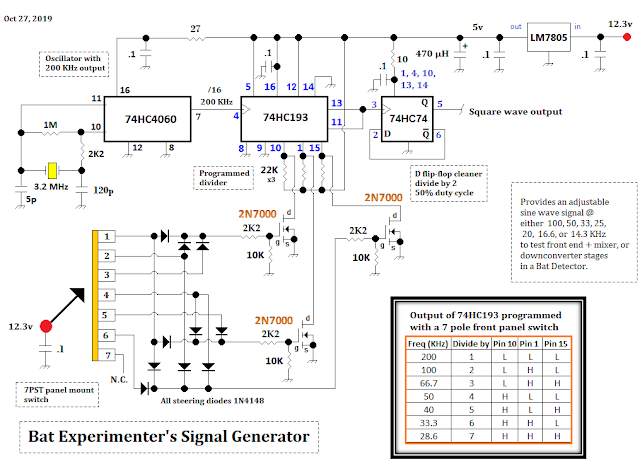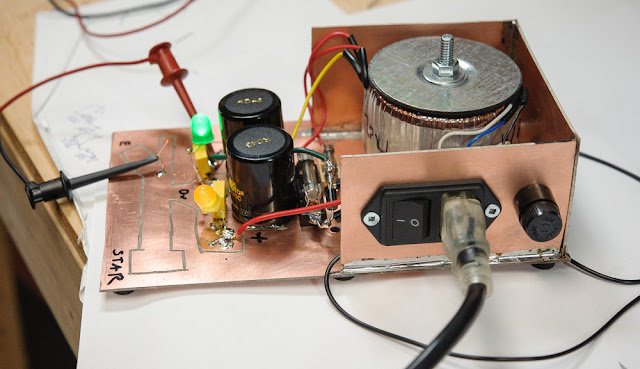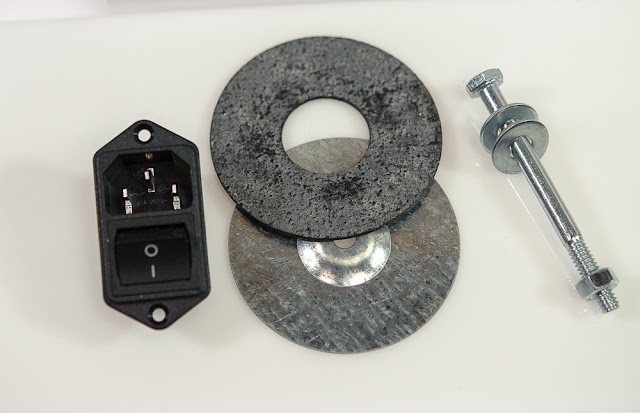This is part 2 of a series about a complete prototype guitar amp.
Part 1 lies here
Part 2 lies here
Part 4 lies here
Power Amp Stage Notes:
Section A The Final Amp | 21 Watt power amplifier for clean jazz guitar.
This amp includes an abundance of medium power transistors: BD139 | BD140 , plus current limiting in the VAS + the final drivers.
Most resistors outside of the input differential pair circuitry are 1/2 watt rated. Most caps are 50 VDC rated. In the schematic above, I've got the 1000 µF filter capacitors going to signal ground for clarity. Actually, they return to their own special ground @ the power supply as discussed in Part 1.
On the bench, I hooked it to my dummy load. I applied a 1 KHz tone and drove it to the brink of distortion as described in here on my Dummy Load page. That's what you see in this FFT.
Above 2 photos — In chassis for testing. I'm using some of the installed rear panel jacks as temporary paths for input into the PA. This allows PA testing and real-world tests of the preamp + tone shaping stages. 2 speaker output jacks wired in parallel provide output possibilities.
I'll go through some notes:
I build circuits from DC to ~ 1.5 GHz on FR4 board using Ugly Construction. Evidently, this frightens some of my readers.
Board Construction & Heat Sinking
I built the PA on 2-sided , 1 ounce copper clad board. Circuit paths, or islands were carved with a motorized tool while outdoors. I also isolated each board mounting hole so the board does not get connected to chassis ground when bolted in. I seek star grounding for each circuit board.
The PA board gets lifted off the chassis by spacers that prevent shorting the power BJT mounting bolts to the chassis [ recall that they're connected to each collector terminal]. This also allows air flow under the PA board for cooling.
Above —Heat sinking the power followers. I bent ~ 20 gauge aluminum with a brake to fashion crude heat sinks. Further, under each heat sink lies a small piece of 24 gauge copper sheeting and under that lies more 24 gauge aluminum stock.
The copper sheeting + aluminum heat sink is secured to the main board with the main power transistor mounting bolt plus an additional 6-32 bolt below each transistor. The additional bolt presses the heat sink & sheets firmly onto the main board — and lowered BJT temperature 3-4 degrees C more than without the extra bolt during tests.
For my 21 W amp, this crude heat sinking worked OK for this, my first solid-state guitar amp. In a test setup with a dummy load, I applied a 1 KHz signal to give 20 Watts output in the DSO & left it that way for 24 minutes ( a torture test ). The big NPN measured 47-49 degrees, while its PNP sister measured 54- 56 degrees C. My heat sink resistors measured 82 degrees C . When playing guitar at a comfortably loud bedroom volume, the transistors run around 23-24 degrees C.
Transistors
For the small signal transistors, I call for the MPSA06 and MPSA56 BJTs, however, by this time, I'd run out of them and applied 2N4401/2N4403. My experiments showed that the MPSA series transistors are better matched from BJT to BJT and likely prove a better choice for the differential input pair at least.
While I chose the very husky MLJ21194 + MLJ21193 as power followers, a 2SA1302 2SC3281 pair, or even the TIP 35C | 36C could work well. All of my parts were brand name & purchased from reputable American dealers. I saw a couple of cheap bootleg transistors let their smoke out during my several PA builds under heavier current.
In previous versions of this amp,I employed T0-92 encased transistors for all but the finals and the BD139-140 BJTs in earlier versions of this amplifier. This proved a big mistake. With mishaps + during torture tests, the VAS transistor quickly or progressively failed and the VBE multiplier died instantly. This led to a current surge and caused the fuses on my AC transformer secondary side to blow.
While T0-92 transistors provided a lovely high Beta, they led to a lot of frustration. In audio amps, and in particular guitar amps, "overbuilding" seems important. Thus, I used a lot of medium power transistors — even for the current sources.
Current Sources
For my build, I ran out of BD140s, so I bolted two TIP42A's onto my circuit for the current sources transistors. I isolated their mounting points and also sought them for mechanical rigidity — a needed thing when you build using Ugly Construction. The current sources exhibited nearly 0 temperature drift once they ran for ~ 1 minute.
I closely measured them in a variety of situations and placed some of this data in Table 1 on the schematic. The input pair get sourced with a lovely high impedance with a current that varies from 6.25 mA to 5.7 under test conditions. I sought around 10 mA for the VAS supply , and measured a range from 10.5 to 8.61 mA with the amp driven to a constant 3W, 5W , 10W and 20 W output.
This shows what happens to my DC power supply under different amplifier power loads. I placed in DC measures in Table 2 below:
Since I'm only going with 1 pair of finals, the VAS current needs to be high enough to fully drive the top half of the AC signal swing @ high output to a potentially low output impedance . For example, with two 8 Ω speakers in parallel which doubles the current needed to drive a single 8 Ω speaker. The emitter follower located before the VAS helps that cause immensely.
Ultimately, For lower current, distortion, heat sinking requirements and DC ripple, I plan to stick to an 8 Ω load, however, i plan to experiment with different speakers and all of mine are currently 8 Ω speakers. If I find 2 speakers I like better together than just a single 8 Ω unit, then I'll order these 2 speakers in 16 Ω for a final future amp.
Amplifier Topology
A basic 3 stage power amp that borrows heavily from the recommendations of Douglas Self. The classic differential transconductance pair serves as the input stage to subtract negative feedback from the input and drive an error voltage to the voltage-amplifier stage or VAS.
In professional power amps, input differential stage emitter + collector resistors get replaced with high Z current sources + mirrors. Discrete transistor current mirrors improve the balance of the input pair across a wide frequency spectrum to cancel the 2nd harmonic. You'll see a variety of current mirrors used extensively within op-amps to boost linearity & reduce HF distortion.
Some designers employ boot-strapped resistors to supply the VAS current and this evidently can also work very well. I went with a current source.
The voltage-amplifier stage [ VAS ] provides all the voltage gain in a solid state power amp. I applied Douglas Self's recommendation of driving the VAS with an emitter follower to reduce distortion and garner more current drive for the followers.
The VAS circuit also contains 2 small COG or NP0 ceramic RF caps to stop HF oscillations. The current limiting transistor helps protects the VAS in event of a catastrophe.
When I first built the amp, I did not connect the final power transistor collector nor base node wires. Every other part was wired in however. Thus I had a small functional amp to test and measure with a signal generator, DMM, DSO or oscilloscope, plus a dummy load.
Above — Output of the amplifier with just the BD139-140 drivers in-situ with a +/-15 volt DC supply. I first test any PA circuit with my +/- 15 VDC bench supply before going to higher DC voltages.
You won't get much power with the 100 Ω degenerative emitter resistors, but can fully test the amp without a lot of current flowing. By tweaking the 1K pot on the VBE multiplier, I also set the bias across points a and b at 1.2 VDC with no input AC signal applied. Thus the bias is at a good starting point for when you connect the power followers.
Finally, connect the power followers and adjust the bias while looking at the output in a scope or DSO plus FFT. The quiescent current of the entire PA ran ~ 22.4 mA. At full clean signal power it will consume around 714 mA if you connect an ammeter between the supply and 1 of the DC rails.
Of negative feedback, folklore and tribalism
This design applies mixed mode negative feedback: voltage and current negative feedback. Both provide series feedback to provide the same function -- to boost PA linearity.
Negative feedback also affects an amps gain, bandwidth and frequency response, plus its input and output impedance (Z). Negative current or voltage feedback affect linearity + gain similarly, but with respect to output impedance, current feedback increases output Z by the size of the feedback factor, while voltage feedback decreases output Z by the feedback factor. To calculate the feedback factor for each type, a different equation gets applied and I won't go into the math.
A classic HiFi solid state amp with just voltage feedback exhibits a very low output Z that is just fractions of an ohm. Delivered power decreases as the speaker Z rises.
For decades, solid state guitar power amp designers have applied current plus voltage negative feedback. This leads some to suggest that the solid state amp is now behaving more like a transformer-coupled tube amp that offers a higher output Z while exhibiting a lower dampening factor.
Some engineers who design audio amplifiers hotly debate current versus voltage source drive. See this brief EDN article by Esa Meriläinen who argues for driving speakers with current rather than a voltage source. I've got papers by respected authors who state the opposite. I'll stay out of this debate.
In my PA, output current is sensed by measuring the voltage drop across a 0.22 Ω resistor in series with the output voice coil. This resistor senses a fraction of the output signal and feedbacks a small voltage to the input stage that is phase inverted and thus "negative feedback". The voltage drop across the 0.22 Ω resistor goes up or down proportionally to the output current. This variable voltage is fed to the 510 Ω emitter resistor in the 2nd half of the input differential pair, As the fed back voltage increases, amplifier gain decreases. E.g. increased voice coil current increases the voltage drop across the current sense resistor and this bucks the amplifiers input signal.
The 10K resistor connecting the power follower collectors to 1/2 of the differential pair's base node provides the voltage feedback.
Output Impedance and Dampening Factor
Going back to your electronics training, for example -- studying linear power supplies. In current feedback, the circuit attempts to keep the output current constant meaning that the output impedance has to be high. For output voltage to be constant the output impedance has to be low. Regardless, whether constant voltage, or constant current, the power delivered is still a function of speaker impedance versus frequency.
Dampening factor is another term that may polarize some guitar amp lovers; especially by those who adore distortion. Dampening factor (aka dampening) = the ratio of loaded Z ( typically 16, 8, 4 Ω ) to the amplifier's output impedance. In guitar world, higher dampening is often considered a bad thing by the cognoscenti. A very low output Z solid state amp dampens the speaker more than a higher impedance transformer-coupled amplifier. This is true according to the arithmetic.
Raising the amplifiers output Z reduces dampening, however, the most significant factor affecting dampening is the series resistance of the speaker voice coil. I once significantly changed the dampening on a friend's solid state amplifier with no soldering — I put in a different speaker with a much lower voice coil DC resistance. He loved the result.
How I chose the 820 Ω feedback resistor. Color you PA Tone
The other board bolted in the amp chassis thus far contains a split-supply voltage regulator for the op-amps used in the preamp and tone shaping circuits, plus this board also houses the first preamp & it's connected to a 1K gain pot.
I connected my guitar to the amp input and routed the output of the first preamp into the power amp input. It's interesting to listen to a guitar amp with no tone control circuit -- and just 1 volume control.
I connected an 8 Ω 12 inch Jensen speaker to the amp and played through it. Instead of the 820 ohm resistor, I place a 1K 2 Watt potentiometer in the feedback loop and tweaked the pot as I played.
I seemed to hear some changes in the bass & treble frequencies at different rotations of the pot. This aurally supports the claim that current feedback tends to boost lows and highs and thus provides a mid frequency scoop. Further, I seemed to prefer 1 particular setting on the pot. I removed the pot and measured it with an ohm meter.
Continuing on, I tried 4 other 8 Ω speakers that I had on hand at the moment. I also tried different speakers in parallel. In most cases, the setting on the pot that I seemed to prefer was different. I also tried longer speaker wires ( 16 foot, 8 foot versus 3 foot ) -- this exhibited a small effect on 2 of the speakers but this in turn felt dependent on the pot setting. Speaker cable resistance can potentially exhibit an effect on dampening in a very low output Z power amp. Normally, I use a 3 foot ( 91 cm) speaker cable
The 1 pot setting that worked as a compromise setting was then determined: 811 Ω, I soldered in a 820 Ω 1 Watt resistor in for now. When I finally complete the amp and decide which speaker(s) to use, I'll repeat my test with a potentiometer.
The current feedback resistor allows for a potential change in the output impedance that can allow for some equalization of the speaker - power amp system in concert with the speakers frequency response + resonant frequency [ speaker resonance often lies somewhere between 75 - 120 Hz and varies from model to model ]. I wonder if adjusting the pot allows you to enhance the resonant frequency of the speaker?
This function paled in comparison to actually changing the speaker. Using speaker choice to dial in whatever desired guitar sound lurks in your head seems critical. Then you can try to tweak it with a current feedback resistor choice.
Section B Faux Amp
Above — Schematic for a faux amplifier I built for plus and minus 15 volts all on 1 PC board to investigate PA stages, plus different preamplifer circuits. Clean signal output = 9.5 Watts, as my bench split supply has a small transformer and normally gets used for developing small signal op-amp circuitry. This was my first split supply power amp and I learned a ton and gained some confidence.
Above — The finals were mounted directly on 2-side copper clad board. At under 10 W power, they did not get above 30C even during maximum power torture tests for 15-20 minute stints.
Above — RCA inputs used for connecting the +/- 15 volt split DC supply to this board. This is OK for a low power experimenter board, or for op-amp circuitry, but not recommended for real power amplifiers.
Above — Entire board. In the forefront lies an RCA jack connected to the PA input.
 Above — FFT with maximum clean signal. Above this drive my power supply voltage sagged excessively and distortion increased exponentially.
Above — FFT with maximum clean signal. Above this drive my power supply voltage sagged excessively and distortion increased exponentially. Above — Time domain. Compared to above, increasing the drive by 1 Vpp produces harsh clipping.
Above — Side view. You can see the power supply rails. Generally you want to keep them closer together, but this was my first go and gave me lots of building space.
Above — Output section. The emitters connect to their resistors through small holes. I wound the coil and held it together with tape. This OK for a temporary project. I connected the output jack to either my dummy load or speaker(s).
I enjoyed this little amp and it sounded great. Surprisingly, a 9.5W amp cranked up proves quite loud in an electronic lab.
Miscellany
Above — This power amp featured parallel power followers to reduce current-induced Beta drop when driving 4 Ω loads into 60 W. I learned from this board that the most important stage in your entire amp = the power supply.
To get desired a output power, your DC supply needs to provide the needed current without sagging too much under full load. Using transistors that are specified to have lower Beta drop, plus putting them in parallel does help the Beta drop issue. The BJTs = MLJ21194 & MLJ 21193. Heat sinking was provided by copper plating on the back side to the board.
















































